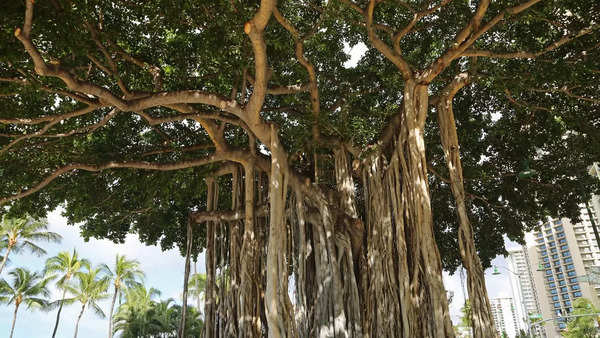One of the main reasons that the banyan tree can spread across so widely is definitely due to it’s aerial roots. These unique roots grow from the branches an stretch their spindly arms towards the ground where they eventually take root and behave as secondary trunks, strengthening and supporting the enormous canopy and allowing the slow but sure spread of the tree cover. Since the aerial or prop roots are firmly embedded in the ground, the tree is solidly anchored and this can withstand strong gales of wind and other environmental challenges.
The banyan tree is a very resilient breed of tree and has a unique adaptability system, seen in few other species. The tree flourishes across a wide range of soil types and climate circumstances, from humid tropics to arid locations. The massive and complex root system allows it to sustain and nourish itself even in the most severe drought as the deep rooted network is able to draw water and nutrients from deep under the earth. Furthermore, the banyan tree has a mutually beneficial connection with specific kinds of fig wasps, which are necessary for pollination. This mutualistic relationship assures the tree’s reproductive success and the survival of the species.

Representative image
The banyan tree’s bark and leaves also play a role in its long life. The bark is thick and resistant to pests and diseases, providing a protective barrier against external threats. The leaves are large and leathery, reducing water loss through transpiration and helping the tree to conserve moisture. These adaptations enable the banyan tree to withstand harsh environmental conditions and continue growing for centuries.
Banyan trees have historically played an important role in many cultures and faiths. In Hinduism, the banyan tree is considered sacred and is frequently associated with the divinity Vishnu. It’s thought to be a symbol of immortality and longevity. The tree is also mentioned in ancient scriptures, including the Bhagavad Gita, where it is depicted as a symbol of the eternal cosmos. In Buddhism, the banyan tree is considered as the location where the Buddha obtained enlightenment. These cultural and religious links have resulted in the protection and preservation of banyan trees in many areas, contributing to their long existence.
The banyan tree’s ability to spread indefinitely is also facilitated by human intervention. In many parts of India and Southeast Asia, banyan trees are planted near temples, shrines, and other significant sites. These trees are often cared for and protected by local communities, allowing them to grow and spread without interference. The practice of planting banyan trees in public spaces has also contributed to their widespread distribution and longevity.
The banyan tree’s remarkable ability to survive for centuries and spread indefinitely is a result of its unique biological characteristics, adaptive nature, and cultural significance. Its aerial roots, robust bark, and symbiotic relationships enable it to thrive in diverse environments and withstand various challenges. The tree’s revered status in many cultures has also played a role in its preservation and continued growth. This remarkable combination of factors makes the banyan tree a symbol of endurance and vitality.
Putin All-Smiles As NATO’s Paratroopers Falter In Mega Aerial Exercise In Poland | Watch
